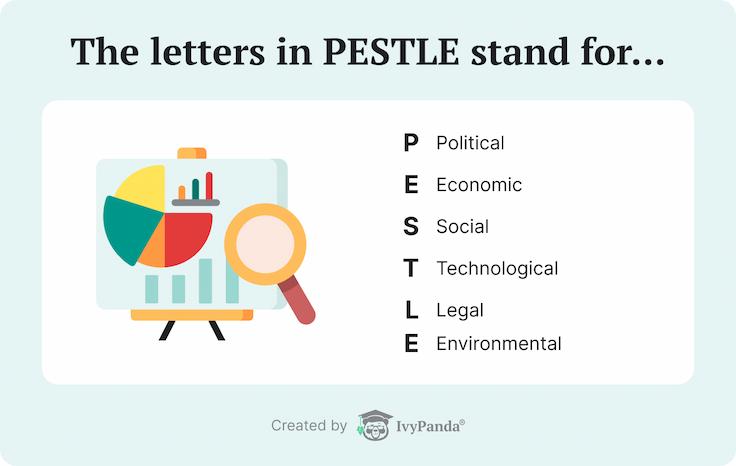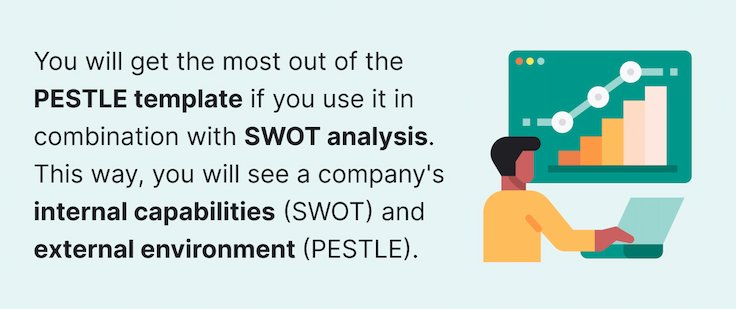Free PESTLE Analysis Template
Get a customized report with this PESTLE analysis template in 3 steps: fill in the fields, choose your favorite PESTLE template, and download the result!
⚙️ PESTLE Template: How Does It Work?
In case you’re wondering how to use this PESTLE analysis template, we’ve listed all the essential steps here.
Step 1: Research the company you chose to analyze. Provide info about the industry, competitors, and other external factors that may affect it.
Step 2: Divide all the data you’ve found into six categories. You should formulate what political, economic, social, technological, legal, and environmental factors influence the business.
Step 3: Fill in the blanks with the collected data. Make sure you are concise and clear in these sections — this info will appear in the final template.
Step 4: Choose the type of your PESTLE table and the color you want in the Settings. You can see how it will look in the Preview section.
Step 5: Finally, download the results of your analysis. You can also get a PESTLE template that you can fill out yourself!
❓ PESTLE Analysis Template – FAQ
🧮 A Breakdown of the PEST Template
The PESTLE framework is a helpful tool for any marketing or business student. It is considered a more extensive approach to strategic planning than SWOT analysis. In this section, we have explained every external factor our free template asks you to determine.

Make sure to identify these factors for a thorough PESTLE analysis:
- Political factors. Who are the key players in the political landscape? What policies may impact your company? Besides, think of regulatory issues, like tax laws or trade agreements. Everything that may affect business operations is worth consideration.
- Economic factors. What are the economic trends in the market? Are there any major market fluctuations or new technologies? Can they affect how people spend their money? Take notes of the inflation rate, foreign exchange rates, growth patterns, etc.
- Social factors. How does community affect people’s preferences? Who are some key influencers that play a role in spreading awareness about products and services (employees, shareholders, etc.)? What groups might want to oppose it? Check how cultural trends, demographics, and other social aspects influence how your target audience uses/buys products.
- Technological factors. What innovations will change the way people use services and products similar to yours? What new technologies could make your item obsolete? Evaluate what recent developments or studies can change the operations in the market.
- Legal factors. What laws currently affect this company or product? What relevant and influential requirements could be passed in the future? Look up safety regulations, consumer laws, etc.
- Environmental factors. What influence does this product have on the environment? What laws or regulations might appear that would alter its carbon footprint? Focus on the climate changes your new products or services might bring out.
🏆 PESTLE Analysis Maker – Benefits & Drawbacks
There are plenty of advantages to the PESTLE system. However, you should learn about its shortcomings as well. You can also find them explored in our free college essays.

Benefits
Drawbacks
👀 PESTLE Analysis Template Examples
Even when you’ve listed all the relevant external factors in the PESTLE template, you still have to analyze them. Here are some student essays that will help you complete the task:
- IKEA’s PESTLE Analysis Essay. The company is arguably the most well-known brand among furniture stores. What makes it so prominent in the field? See this academic paper to find out.
- Entrepreneurship: Amara Online Shoe Shop Proposal. If you’d like to see how to explore both internal and external factors of the same organization, read this piece. It demonstrates SWOT and PESTLE analyses.
- Toyo Tires Company’s PESTLE Analysis. Read this report to see a thorough examination of different external factors.
Thank you for reading this article! We hope the PESTLE analysis template above will help you in your studies. Share it with your friends if you found it useful! You can also check other business tools we have: VRIO template, SWOT analysis, SOAR matrix, and 5 Forces model.
Updated: